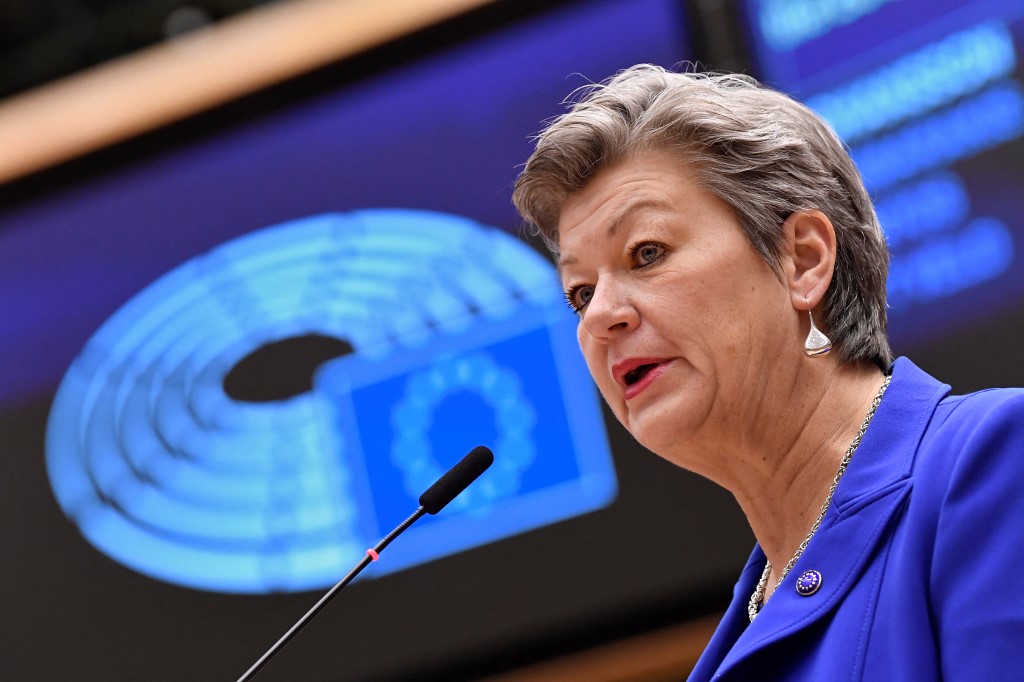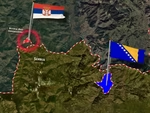
As regards prevention of illegal migrations, it is much better to return persons without the right to asylum to their countries of origin than to build walls and barbed wire fences on borders, European Home Affairs Commissioner Ylva Johansson has said.
The issue of migrations, which has been burdening the European Union for years and will be one of the two main topics of an extraordinary EU summit next week, was discussed by Johansson in an interview with correspondents of news agencies active within the European Newsroom, including the Croatian state news agency Hina.
Asked by Hina what the EU can do to reduce the pressure on Croatia’s border, which is now the external border of the EU and the passport-free travel area, Schengen, and prevent the accumulation of migrants in Bosnia and Herzegovina, Johansson said that the efficient repatriation of migrants without the right to asylum is an excellent deterrent for illegal entries to the EU.
We have been helping Bosnia and Herzegovina return migrants to their countries of origin very successfully, whether the returns are on a voluntary basis or forced, the EU official said, noting that Croatia’s accession to the Schengen area had passed without problems and that there were no indications that there would by any.
She said that former Bosnian Security Minister Selmo Cikotic had told her that the repatriation of illegal migrants had reduced the number of illegal arrivals from that country.
Repatriation is therefore an important instrument in preventing irregular arrivals and more should be done to continue with it, she said.
At the start of last autumn, a large number of migrants started arriving via the Central Mediterranean route (towards Italy), the Eastern Mediterranean route (via Turkey and Cyprus to Greece) and the Western Balkan route, but this was stopped through joint efforts, Johansson said.
In the last two months of 2022, a drop in the number of illegal arrivals via the Western Balkan route of one-third was registered, she said.
Demands put before Serbia
The increase in illegal arrivals in the EU, and there were 330,000 in 2022, is not due to wars or persecution.
There is a more or less normal number of irregular arrivals from countries where there is a risk of war or persecution. But the number of arrivals from Turkey, Georgia, India, Cuba, Egypt, Tunisia, Morocco, Bangladesh, and Pakistan has been growing and those asylum applications are granted in a very small number of cases, Johansson said, concluding that the increase in irregular migrations has not been triggered by wars.
The EU has asked Western Balkan countries, notably Serbia, to align with the European visa policy.
We have asked them to align their visa policies when it comes to Cubans and citizens of the other countries and they have responded positively. Serbia and North Macedonia have aligned their visa policy on Cuba and the results are already visible. They have done the same with regard to India, Tunisia, Burundi and Guinea-Bissau, Johansson said.
Almost one million asylum applications
In 2022 a total of 924,000 requests for asylum were submitted, which is almost three times the number of illegal arrivals, which means that most applicants arrived in the EU legally.
Some of them were granted entry visas and stayed after their expiry and some left for another EU country and filed an asylum request there. A significant number of migrants submit visa applications in more than one member-country.
This causes great pressure on reception centres in countries like Belgium and the Netherlands, which are overcrowded, and most of those people are not entitled to international protection. Last year, only 39% of the asylum requests were granted.
Johansson notes that it is therefore important to repatriate people who do not have the right to asylum to show that one cannot arrive and stay in the EU just like that.
It is therefore necessary to increase the number of repatriations. In 2022, 300,000 decisions to that effect were made and only 70,000 people were returned, Johansson said, noting that greater progress in that regard is possible only if the European Commission and member-countries cooperate.
No money for wire fences, walls
Building walls and barbed wire fences across the EU is not a good solution for many reasons. We have a long-standing principle not to finance walls and barbed wire fences and I think that we should not change that, Johansson said.
On the other hand, if member countries that finance their border protection mostly from their own budgets and know best how to protect their borders, wish to build walls and barbed wire fences, I don’t have a problem with that, Johansson said, but noted that that cannot be financed from the EU budget.
EU funding for border management and protection is not unlimited.
For the budget period 2021-2027 the EC proposed €11.4 billion for the protection of the external borders. The Council decided to halve it. I have €6 billion for 27 members to finance external border protection over the seven-year period and that is why it is necessary to finance the priorities, said Johansson.
New pact on migrations?
After the big migrant crisis of 2015, the previous Commission, headed by Jean-Claude Juncker, proposed mandatory quotas for the distribution of migrants across member countries so as to reduce the burden on the countries on the EU’s external border that had been under the largest migrant pressure.
This was an attempt to reform the Dublin Regulation under which the asylum request is considered in the country where the migrant entered the EU. This functioned well in normal times but with large-scale migrant arrivals, the first countries of entry, like Greece and Italy, had to cope with huge migrant pressure.
The proposal for a mandatory allocation of migrants, however, caused great divisions among the member states and they still have not been overcome.
The new EC, led by President Ursula von der Leyen, in September 2020 proposed a new pact on migrations and asylum whose main element is replacement of mandatory quotas with binding solidarity. In other words, those countries that do not want to take in people who have the right to asylum have to find another way, mostly financial, to help those that do.
Commissioner Johansson says that at the start of the new EC’s term the atmosphere regarding migrations was very toxic, with divisions among the member states, the Council of the EU and the European Parliament, but that the situation has changed completely in the meantime, with member countries cooperating and listening to one another.
The migration and asylum pact contains a number of legislative proposals and initially there was no great progress in efforts to reach a consensus due to insistence on a consensus on the entire document.
Progress was made in the first half of 2022, when the EU was chaired by France which proposed that the pact be negotiated step by step.
So far agreement has been reached on five files from the pact and during the Czech presidency of the EU in the second half of 2022 agreement was reached in principle on a solidarity mechanism. Now that agreement is expected to translate into a legal text.
The current Swedish EU Presidency has set as its goal reaching an agreement on a regulation on asylum and migration management by June, and that is one of the most difficult parts of the pact.
Johansson said that now it is important to agree on the entire pact by the end of the EC’s term, noting that she believes that this will be possible, but that once agreed, it will take several years to implement it.
Kakvo je tvoje mišljenje o ovome?
Učestvuj u diskusiji ili pročitaj komentare





 Srbija
Srbija
 Hrvatska
Hrvatska
 Slovenija
Slovenija



























































